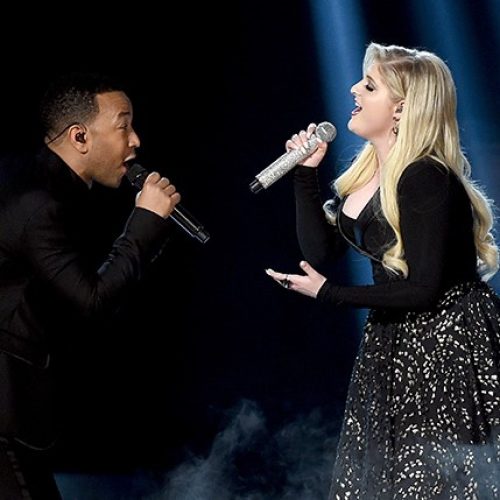Meghan Trainor got old fast, didn’t she? Not like “gosh, all her teeth fell out” old, I mean like “okay, it was cute for a while, but I’m just honestly pretty tired of your music” old.
“All About That Bass” went from endearing to annoying pretty quick (sometime around the 341st time you heard it).
But then, something magical happened.
And I say that without an ounce of my characteristic condescension and snark. Something magical did happen. And by “something,” I mean she teamed up with John Legend to give us perhaps the best love song of the decade in “Like I’m Gonna Lose You.”
The first time I heard this song, I was driving my younger brother to soccer practice. We had just pulled to a stop outside the high school, and the first few notes came wafting from the radio. I had been completely tuning out whatever was on before, but those first few notes grabbed me, and I sat there in the running car, just listening, until it was over.
And when I found out it was Meghan Trainor, I realized that I probably owed her an apology.
You don’t make a song that hits someone like that without a lot of talent (I’m sorry, Meghan; I was officially wrong).
So, what stands out about this song specifically? Two things, mainly. The first is that the vocal performances are just staggering. Both singers are hugely talented as individuals, hitting all of the sweet and soulful moments exactly right, and they have voices that layer well together. Unfortunately, if you’re reading this to get ideas on how to write a great song, I suppose “be an amazing singer” isn’t the most useful advice, but hey, if you can pull it off, it helps.
And though there aren’t that many was to improve your voice (beyond a whole ton of practice and a few lessons), there are ways to write a song that help set your voice up for success. When it comes to ballads like this one, there’s something to be said for making one simple change to the time-signature.
Author’s Note: Well, I can say with some authority, earned through my personal experience of trying to this article, that it’s HARD to describe time signatures to someone using only words. I tried it a few different ways, and it just didn’t fly. So, if you know the difference between 4/4 and 12/8, keep reading. If you don’t, watch this video, learn something, and then keep reading.
To really get a sense of what I’m talking about here, do me a favor. Listen to “Perfect,” perhaps the best love song on the radio right now.
And go back up to listen to “Like I’m Going to Lose You,” perhaps the best love song of the decade.
And listen to “At Last,” perhaps the best love song of all-time.
What do they all have in common? The same, unusual time-signature. They’re all in 12/8 (and so is the Game of Thrones theme song, interestingly enough).
People don’t think about time-signatures that often, especially in radio singles. 4/4 is standard, and it works. 1, 2, 3, 4. Doesn’t need to be more complicated than that.
But the strength of 12/8 is that it feels like 4/4, but swings. It’s easy to do, because it follows all the same rules as 4/4 (still 1, 2, 3, 4!), but it carries a slow song along by giving it some momentum that just wouldn’t be there without that extra eighth note in every beat.
This is the second thing worth pointing out that makes this song worth paying attention to. Yes, it’s sung beautifully. But it’s helped along by how it’s written, which is a trick you should steal for the next ballad you try to write. Set yourself up for success, and write the song in the time-signature that stops boring love songs from being boring love songs.
Slow can be great. Slow can be nice. But adding a 12/8 meter to a song can take it to the next level, making a slow song into a slow, swinging jam.
It worked for Meghan Trainor, and it can work for you, too. And the next time a ballad catches your ear, test it for that triplet pulse. You might just be surprised how often it shows up.
Author’s Note: Though, now that I’ve written this piece about how great 12/8 is, I’m sure you’ll never come across it ever again, and you’ll think I’m making this all up. Sorry, that’s just how these things work.







